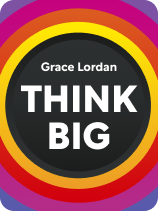

This article is an excerpt from the Shortform book guide to "Think Big" by Grace Lordan. Shortform has the world's best summaries and analyses of books you should be reading.
Like this article? Sign up for a free trial here.
How do cognitive biases affect your decision-making? What false stories in your head keep you from your goals?
If you want to change your life, you must understand how to overcome the cognitive biases—the mental shortcuts that all humans take—that hinder you from achieving your goals. Grace Lordan shares four ways you can tackle cognitive biases head-on and get on with pursuing your dreams.
Keep reading to learn how to overcome cognitive biases and become the person you want to be.
What Are Cognitive Biases?
To understand why it’s necessary to learn how to overcome cognitive biases, we must first understand what they are. Lordan explains that, despite popular opinion, humans are not rational beings. Rather, we’re all subject to cognitive biases—systematic errors in thinking that occur when we process and interpret information in a way that differs from objective reality. These biases often lead us to make decisions that aren’t in our best interests long-term.
(Shortform note: If cognitive biases lead us to make decisions that aren’t in our best interests long-term, why do we have them? Some experts theorize that cognitive biases helped early humans survive back when they regularly faced imminent dangers. They didn’t need to make the most rational decisions; they just needed to make quick decisions that would keep them alive. However, these cognitive biases don’t function as well in the modern world, where success relies more on long-term thinking.)
Cognitive biases affect the decision-making processes of all humans, so these biases necessarily affect your life. Lordan contends that most of the cognitive biases you’ll encounter are your own; so, if you want to achieve your goals, you need to know what they are so that you can better work around them. You’ll also encounter others’ biases—and while you can’t control how they deal with those biases, you can learn how to work around the biases of any gatekeepers you encounter on your way to achieving your goal.
(Shortform note: Although Lordan emphasizes the control you have over your life, other experts suggest that your social circle’s behavior has a big impact. The social proximity effect suggests that the habits of your social circle greatly impact how you behave; for example, if your spouse is obese, you’re 37% more likely to become obese. So, how can you change if your social circle is consistently limited by their cognitive biases? In Everything Is Figureoutable, Marie Forleo suggests that you’re more likely to follow a particular philosophy if your social circle also believes in said philosophy; so, be mindful of whom you spend your time with. Similarly, teaching your social circle how to work around both their own and others’ cognitive biases may improve the chances that you will, too.)
Recognize & Overcome Cognitive Biases
Next, we’ll discuss how to recognize and address internal obstacles by getting confident, managing your time well, staying on track, and learning to bounce back.
Get Confident
Lordan suggests that in order to confidently pursue the actions necessary to become your ideal self, you must overcome the personal stories that are hindering your progress. We all have stories that we tell ourselves about who we are—and thanks to confirmation bias, we pay attention to any evidence that confirms these stories and ignore anything that contradicts them. But some of these stories might prevent you from pursuing your goal. Identify these limiting stories by examining the anxieties that arise when you refuse a potentially advantageous situation. Then, identify any actions you might take to disprove this story and create a new one.
Confidently pursuing your goals also requires that you put yourself out there. Lordan explains that we often don’t take potentially risky actions (like chasing our goals) due to anticipatory loss aversion: We expect any potential failures to feel worse than any potential success. We may also refuse to act due to how badly we expect others to react to our failure—a cognitive bias known as the saving face effect. But in reality, we tend not to feel as badly as we expect to when we do fail. Moreover, since we suffer from a spotlight effect that makes us think people are paying more attention to us than they actually are, people tend not to judge us as badly as we expect them to. Reminding yourself of these realities can help you put yourself out there.
Manage Your Time Well
No matter how confident you are, you won’t successfully implement your plan unless you manage your time well. To do so, Lordan recommends that you plan for more time than you think you need. This is because we’re subject to the planning fallacy: a chronic tendency to underestimate how long it will take to do something. To reduce its effect on your schedule, start by multiplying how much time you think something will take by 1.5, and schedule your tasks accordingly. Then, keep a record that compares how much time you thought you’d spend on a task with how much time you actually spent. Eventually, you’ll notice patterns that will indicate just how much you underestimate the time certain tasks will take and so be able to plan better.
That said, Lordan recommends that, if you’re planning to focus on a single task, you should generally plan to work on it for about 90 minutes at a time. You’re most productive and learn best when you achieve flow, which is when you’re so absorbed in a task that you stop paying attention to anything else and even forget about the passage of time. While you may struggle to reach flow at first, eventually, you’ll be able to work with flow for 90 minutes. That 90-minute limit also ensures that you remain productive; flow exhausts you, so even if you schedule more than 90 minutes, you probably won’t be able to work for more than 90 minutes.
Managing your time well doesn’t just involve scheduling time to work on your goals; it also requires that you actually work on your goals when you say you will. Lordan recommends two strategies for doing so. First, implement short-term rewards for performing your desired behavior and short-term negative consequences for not doing so. Humans tend to avoid doing things that are beneficial long-term if they’re immediately unpleasant; making the beneficial behavior pleasant in the short term circumvents this tendency.
Second, instead of judging your output by how well you complete one task—like “create a presentation”—decide in advance how much you’d get done on a very productive, moderately productive, or slightly productive day. Then, when the day comes, tailor how much work you’ll do based on your energy levels. Even if you’re low in energy on a particular day, you’ll likely often choose the moderately productive option due to the compromise effect—our propensity to shy away from extremes. Scientists have seen this propensity when evaluating people’s purchasing decisions, but Lordan speculates that we may also prefer the middle-of-the-road option in other areas—like when choosing how much work to do.
Reflect on Your Progress
Another key element of successfully implementing your plan is to regularly reflect on your progress. Lordan suggests two methods of doing so. First, Lordan suggests that you regularly reflect on your ideal self. As we learned earlier, the more salient something is, the more we pay attention to it. So the more often you envision your ideal self, the more motivated you’ll be to continue working to become that person—despite any boredom you may feel.
(Shortform note: Regularly envisioning your ideal self may also help you become that person by harnessing the Law of Attraction. In The Secret, Rhonda Byrne suggests that thinking positive thoughts will attract success. So if you ask for what you want and strongly believe that you’ll get it—such as by envisioning your ideal self—the universe will conspire to bring that belief to life.)
Second, Lordan suggests that you regularly reflect on your successes and failures. After each major success or failure, reflect on the most impactful decisions you made that led to that outcome. If this success or failure involved another person’s evaluation, try to see if you can learn why they made that evaluation. Then, decide how much of the outcome depended on things that you did and how much depended on factors outside of your control—like others’ budgets or unforeseeable emergencies. By doing so, you’ll gain a better understanding of what you’re doing well and what you might need to change. This reflection will also help you avoid self-serving bias: the tendency to attribute wins to your internal qualities and losses to external factors.
(Shortform note: In Think Like a Rocket Scientist, Ozan Varol also recommends analyzing how much of an outcome depended on factors that were within your control and how much depended on factors outside of your control. But he says that it’s even better if you perform a similar analysis before making big decisions. To do so, imagine that you’ve made a particular decision that went horribly wrong. Then, try to explain why it went wrong, estimate a rough probability for each issue, and come up with ways to avoid those pitfalls. By doing so, you’ll reduce the chances that you’ll attribute wins to your own internal qualities and grow complacent about success instead of proactively dealing with things that could go wrong.)
Bounce Back
Regularly reflecting on your failures may help you decide what you need to do differently, but whether you persist through setbacks depends on your resilience—your ability to withstand, adapt to, and recover from adversity.
Lordan suggests several strategies you can use to bounce back better from adverse events. First, create a list of things to distract you when you’ve had a bad day. Then, do something from this list—whether that’s taking a bubble bath or partaking in a favorite hobby—whenever you face a setback. Distracting yourself from the initial pain of the failure will help diminish that pain so you’re better able to deal with it. Calming yourself down will also prevent you from making rash decisions in the heat of the moment—a tendency caused by the affect heuristic, our tendency to make decisions based on how we’re feeling instead of logical reasoning.
Second, Lordan recommends that you regularly practice gratitude. Humans pay more attention to losses than we do to gains, which can make us feel worse about our lives and reduce our ability to bounce back. By regularly practicing gratitude, you remind yourself of all the good things in your life. As a result, you’re better able to handle failures because you’re able to counterweight their impact with the acknowledgment of the positive.
You can also bounce back better from potentially adverse events by redefining what counts as an adverse event. To do so, Lordan suggests that you stop comparing yourself to others. No matter how well you do, you won’t achieve satisfaction if you compare your own success to that of others—because someone else will always be doing better than you. Instead, compare yourself to yourself: In other words, judge your growth by comparing your current self to your past self. If you stop using others’ accomplishments to evaluate your own success, you’ll stop being upset by their accomplishments.

———End of Preview———
Like what you just read? Read the rest of the world's best book summary and analysis of Grace Lordan's "Think Big" at Shortform.
Here's what you'll find in our full Think Big summary:
- Why most of our attempts to transform our lives fail
- How to overcome the cognitive biases that hold us back from our goals
- How to take the necessary small steps to change your life long term






